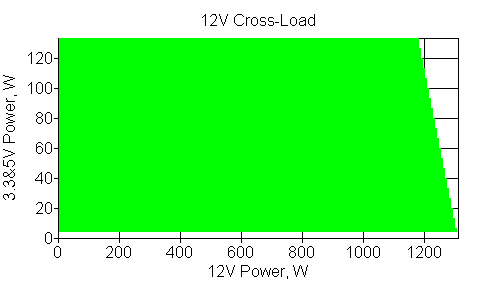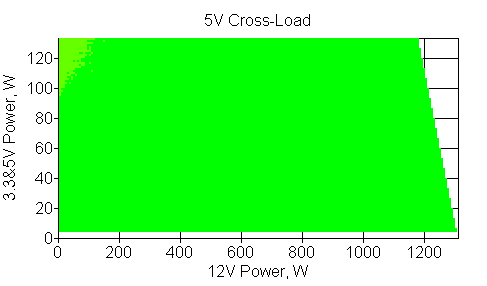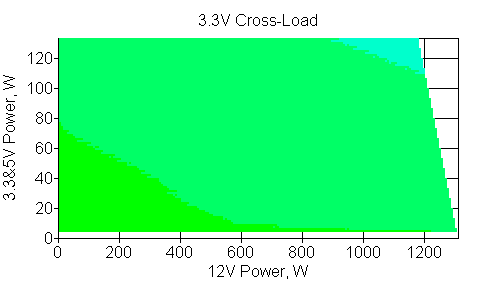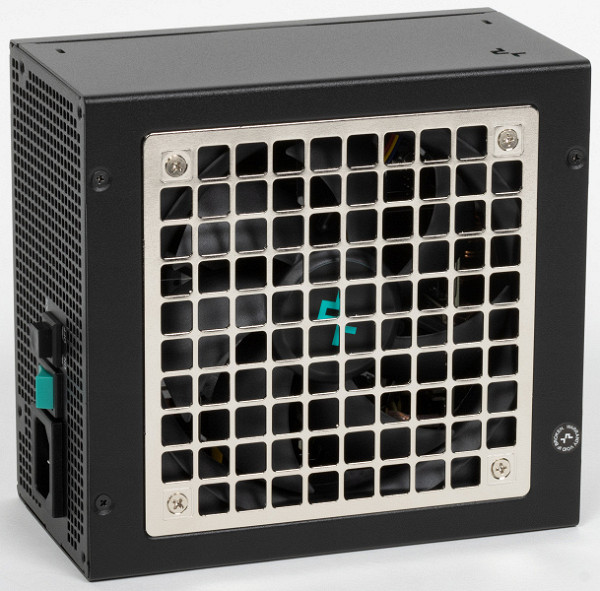
High power supplies starting from 1000 W are usually chosen for specific applications such as system testing, high-load computers for rendering, calculations or overclocked systems. Sometimes such power supplies are also purchased in order to create a power reserve for the current system or to take into account a future upgrade. There are many models available in the market and choosing the right one can be a daunting task. Let's look at one of the available options.
The new DeepCool PX1300P power supply is 80+ Platinum certified and uses only Japanese capacitors. It is equipped with a hybrid cooling system that allows the fan to not spin under certain operating conditions. There is a cooling mode switch on the case. This power supply is ATX 3.0 compliant and supports modern graphics cards via a 16-pin PCIe 5.0 (12VHPWR) connector. At the time of writing the review, the price of DeepCool PX1300P started at 30 thousand rubles.
The length of the power supply housing is approximately 160 mm, including additional space (15-20 mm) for wires. These sizes can be considered compact for high power power supplies. However, modern models with a power of about 1000 W sometimes fit into standard 140 mm long cases, and not just larger ones, as was previously the case.
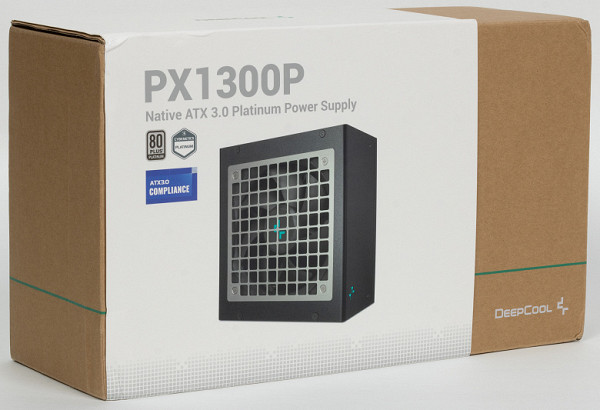
The power supply is supplied in an unpainted cardboard box with color printing, protected by a thick paper dust jacket. This dust jacket, which is essentially disposable, is placed over the top of the box. A distinctive feature of the packaging is its opening — not with a wide wall, as usual, but with a narrow one, which is more typical for packaging household appliances. Opening the box reveals a vertically positioned power supply, as well as a separate box of accessories. The power supply box is not equipped with carrying handles, which corresponds to modern trends in packaging power supplies, regardless of their weight.
Characteristics
All necessary parameters are indicated in detail on the power supply housing. The power value for the +12VDC bus is 1299.6 W, which is almost equal to 100% of the total power, exceeding 99.9%. This indicator indicates a high level of efficiency of the power supply.
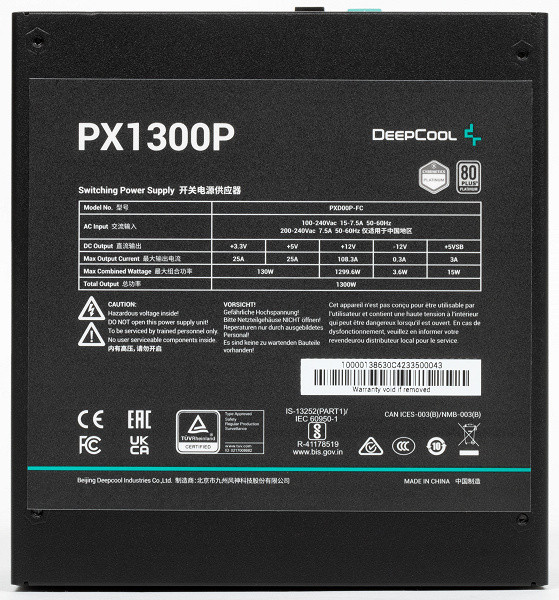
Wires and connectors
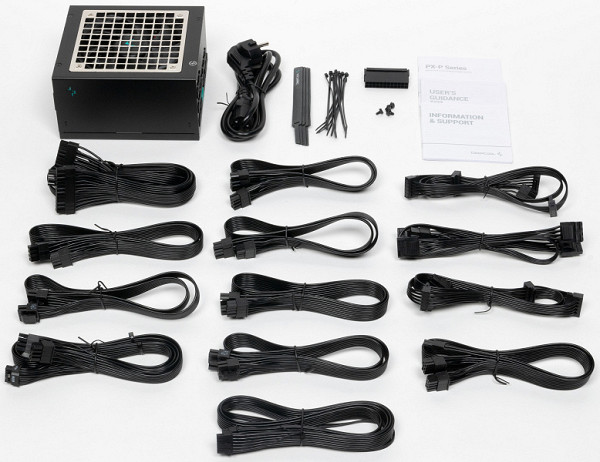
| Connector name | Number of connectors | Notes |
|---|---|---|
| 24 pin Main Power Connector | 1 | collapsible |
| 4 pin 12V Power Connector | — | |
| 8 pin SSI Processor Connector | 2 | collapsible |
| 6 pin PCIe 1.0 VGA Power Connector | — | |
| 8 pin PCIe 2.0 VGA Power Connector | 5 | on 5 cords |
| 16 pin PCIe 5.0 VGA Power Connector | 1 | |
| one more 16 pin PCIe 5.0 VGA Power Connector or two more PCIe 2.0 VGA Power Connectors | 1/2 | double sided cord |
| 4 pin Peripheral Connector | 4 | ergonomic, on one cord |
| 15 pin Serial ATA Connector | 8 | on 2 cords |
| 4 pin Floppy Drive Connector | — |
Length of wires to power connectors
Without exception, all wires are modular, that is, they can be removed, leaving only those that are necessary for a particular system.
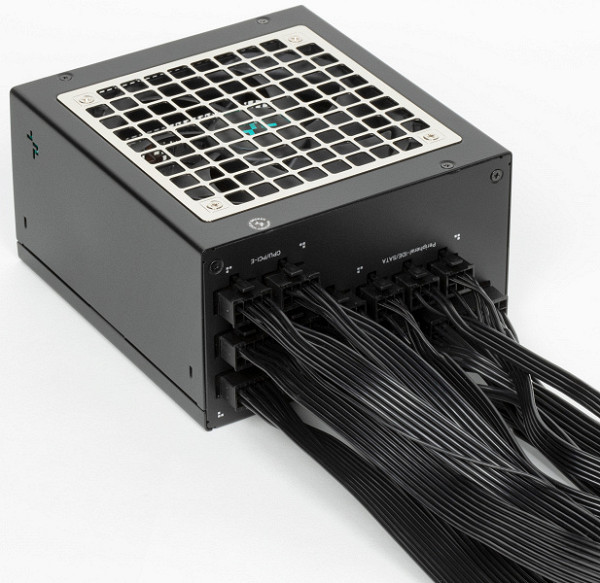
- The cord to the main ATX connector is 60 cm.
- Cable to the 8-pin SSI processor socket — 70 cm.
- Cable to the video card power connector PCIe 5.0 VGA Power Connector — 65 cm.
- Five cords to the video card power connector PCIe 2.0 VGA Power Connector — 65 cm.
- Adapter cord from a PCIe 5.0 connector to two PCIe 2.0 connectors or vice versa — 65 cm.
- Two cords to the first SATA Power Connector — 50 cm, plus 15 cm to the second, another 15 cm to the third and another 15 cm to the fourth same connector.
- The cord to the first Peripheral Connector (Molex) is 50 cm, plus 15 cm to the second, another 15 cm to the third and another 15 cm to the fourth similar connector.
The length of the wires is sufficient for convenient use in full tower cases and similar sizes with an upper power supply. Even in cases up to 55 cm high with a bottom power supply, the wire length will be sufficient for installation. The package includes a standard adapter cord with a PCIe 5.0 connector on one end and two PCIe 2.0 connectors on the other, providing flexible options for using PCIe connectors. However, the number of SATA Power connectors is limited to eight, which may be inconvenient for users who need more. It is important to note that the SATA Power connectors are angled, which can be inconvenient when used with devices located on the back of the motherboard base. Ease of assembly is enhanced by the use of ribbon wires to the connectors.
Circuit design and cooling
The power supply is equipped with an active power factor correction and covers a wide range of supply voltages from 100 to 240 volts. This ensures reliable operation in conditions of low voltage in the electrical network, which does not fall below the established standard values.
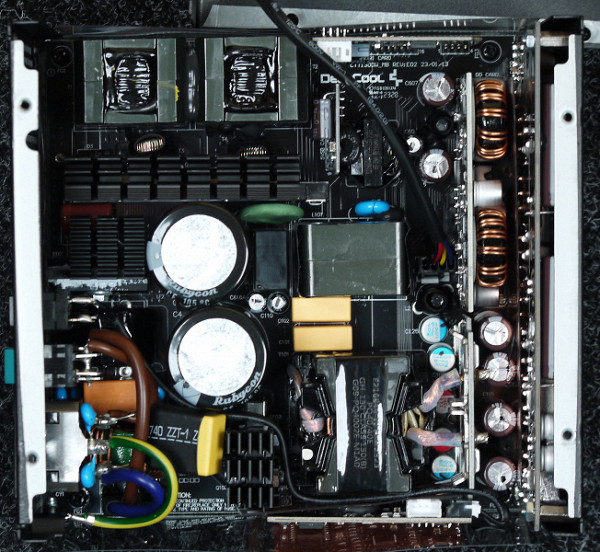
The structure of the power supply is fully consistent with modern trends, including an active power factor corrector, a synchronous rectifier for the +12VDC channel, and independent switching DC-DC converters for the +3.3VDC and +5VDC lines.
The high-voltage semiconductor elements are grouped on a single heatsink, which also includes an input rectifier. The synchronous rectifier elements are installed on the front side of the main printed circuit board. The transformer is also equipped with its own radiator.
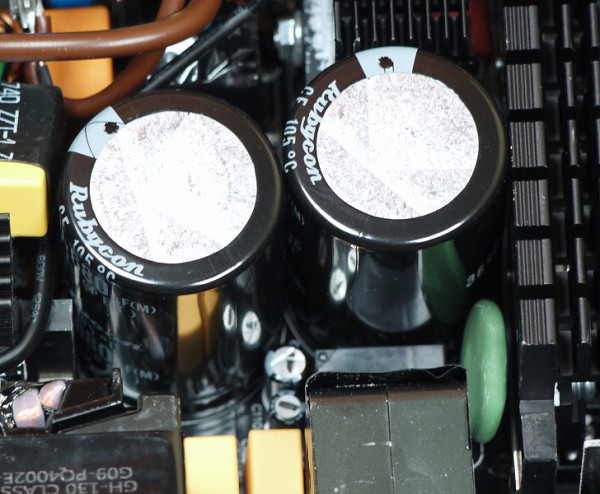
Independent sources of +3.3VDC and +5VDC are located on the daughter printed circuit board and, as usual in the case of power supplies with active cooling, are not equipped with additional heat sinks.
The device contains capacitors exclusively from Japanese brands: Nippon Chemi-Con and Rubycon, as well as a significant number of polymer capacitors.
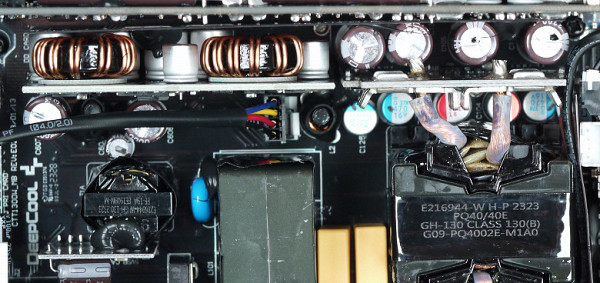
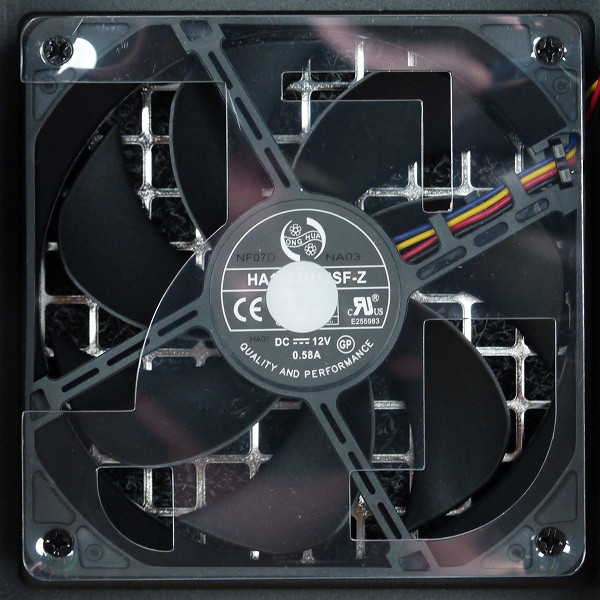
The power supply contains a HA13525H12SF-Z fan (2300 rpm), based on a hydrodynamic bearing and manufactured by Dongguan Honghua Electronic Technology. The fan is connected via a four-wire connector, which indicates the presence of PWM fan control.
Electrical Characteristics Measurement
Then we begin to conduct an instrumental analysis of the electrical characteristics of the power source, using a multifunctional stand and other necessary equipment.
The deviation of output voltages from the nominal value is coded by the following color designation:
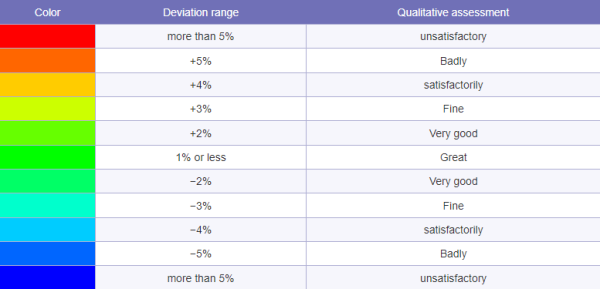
Operating at maximum power
The first stage of testing is to operate the power supply at maximum power for a long time. Such a test allows you to confidently verify the functionality of the power supply.
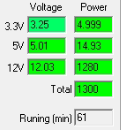
Cross-load characteristic
The next step in instrumental testing is to construct a cross-load characteristic (CLC) and display it on a quarter-plane, where one axis (ordinate) is limited by the maximum bus power of 3.3&5 V, and the other axis (x-axis) is limited by the maximum bus power of 12 B. At each point, the measured voltage value is represented by a color marker depending on the deviation from the nominal value.
The cross-load characteristic (CLC) allows you to determine the acceptable load level for the power supply being tested, especially on the +12VDC channel. In this case, deviations of the current voltage values from the nominal value on the +12VDC channel do not exceed 1% within the entire power range, which is a very satisfactory result. With a typical power distribution between channels, deviations from the nominal do not exceed 2% for the +3.3VDC channel, 1% for the +5VDC channel and 1% for the +12VDC channel.
This particular power supply proves to be an excellent choice for high-power modern systems due to the high practical load capacity of the +12VDC channel.
Load capacity
The next stage of testing is to determine the maximum power that can be transmitted through the corresponding connectors, subject to a normalized voltage deviation of 3 or 5 percent from the nominal value.

In the case of a video card with a single power connector, the maximum power over the +12VDC channel is at least 150 W with a deviation within 3%.

If we consider a video card with two power connectors and the use of two power cords, then the maximum power over the +12VDC channel is at least 350 W with a deviation within 3%. This makes it possible to use high-power graphics cards.

When loaded through three PCIe 2.0 connectors, the maximum power over the +12VDC channel is at least 650 W with a deviation within 3%.

When using the processor power connector, the maximum power on the +12VDC channel is at least 250 W with a deviation within 3%. This is sufficient for conventional systems equipped with only one processor power connector on the motherboard.

When loaded through two processor power connectors, the maximum power via the +12VDC channel is about 470 W with a deviation within 3%.

In the case of a motherboard, the maximum power over the +12VDC channel is at least 150 W with a deviation of 3%. Considering that the board itself consumes about 10 W through this channel, high power may be necessary to power expansion cards, for example, video cards without an additional power connector. Such video cards usually have a consumption of around 75 W. However, it is unlikely that anyone will use them with such a power supply.
Cost-effective and efficient
When assessing the efficiency of a computer power supply, you can choose from two paths. The first method involves evaluating the power supply as a standalone electrical energy converter, then attempting to minimize the resistance of the power transmission line from the power supply to the load. This is usually accompanied by connecting the power supply to all available connectors, which creates different conditions for different power supplies. However, in real-life applications, the power supply is rarely connected to all connectors at once, and therefore this method does not always reflect real-life conditions of use.
The second method is more practical and is associated with assessing the efficiency of a computer power supply. Economy is defined here as the loss of power during the conversion of electricity and its transmission to end consumers. The evaluation is based on power dissipation, the difference between the input and output values of the power supply, and the energy consumed by the power supply over a certain time under constant load. The data obtained allows us to determine the real difference in electricity consumption by different models of power supplies and evaluate the economic efficiency of their use.
Thus, the evaluation of a power supply includes an analysis of power dissipation and operating costs in real-world conditions, which provides a more complete picture of its efficiency.
| Load through connectors | 12VDC, Вт | 5VDC, W | 3.3VDC, W | Total power, W |
|---|---|---|---|---|
| main ATX, processor (12 V), SATA | 5 | 5 | 5 | 15 |
| main ATX, processor (12 V), SATA | 80 | 15 | 5 | 100 |
| main ATX, processor (12 V), SATA | 180 | 15 | 5 | 200 |
| Main ATX, CPU (12V), 6-pin PCIe, SATA | 380 | 15 | 5 | 400 |
| Main ATX, CPU (12V), 6-pin PCIe (1 cord with 2 connectors), SATA | 480 | 15 | 5 | 500 |
| main ATX, processor (12 V), 6-pin PCIe (2 cords per 1 connector), SATA | 480 | 15 | 5 | 500 |
| Main ATX, CPU (12 V), 6-pin PCIe (2 cords x 2 connectors), SATA | 730 | 15 | 5 | 750 |
The results obtained look like this:
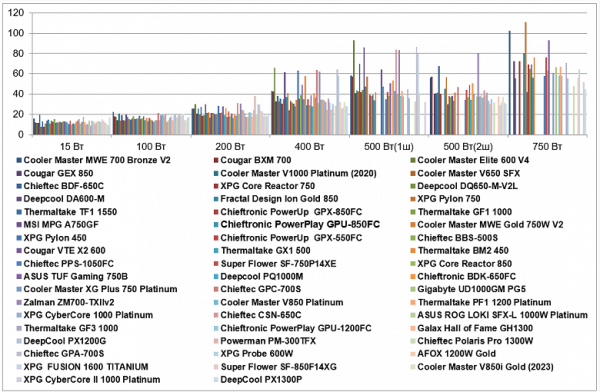
| Power dissipation, W | 15 W | 100 W | 200 W | 400 W | 500 W (1 cord) | 500 W (2 cords) | 750 W |
|---|---|---|---|---|---|---|---|
| Cooler Master MWE Bronze 750W V2 | 15.9 | 22.7 | 25.9 | 43.0 | 58.5 | 56.2 | 102.0 |
| Cougar BXM 700 | 12.0 | 18.2 | 26.0 | 42.8 | 57.4 | 57.1 | |
| Cooler Master Elite 600 V4 | 11.4 | 17.8 | 30.1 | 65.7 | 93.0 | ||
| Cougar GEX 850 | 11.8 | 14.5 | 20.6 | 32.6 | 41.0 | 40.5 | 72.5 |
| Cooler Master V1000 Platinum (2020) | 19.8 | 21.0 | 25.5 | 38.0 | 43.5 | 41.0 | 55.3 |
| Cooler Master V650 SFX | 7.8 | 13.8 | 19.6 | 33.0 | 42.4 | 41.4 | |
| Chieftec BDF-650C | 13.0 | 19.0 | 27.6 | 35.5 | 69.8 | 67.3 | |
| XPG Core Reactor 750 | 8.0 | 14.3 | 18.5 | 30.7 | 41.8 | 40.4 | 72.5 |
| Deepcool DQ650-M-V2L | 11.0 | 13.8 | 19.5 | 34.7 | 44.0 | ||
| Deepcool DA600-M | 13.6 | 19.8 | 30.0 | 61.3 | 86.0 | ||
| Fractal Design Ion Gold 850 | 14.9 | 17.5 | 21.5 | 37.2 | 47.4 | 45.2 | 80.2 |
| XPG Pylon 750 | 11.1 | 15.4 | 21.7 | 41.0 | 57.0 | 56.7 | 111.0 |
| Thermaltake TF1 1550 | 13.8 | 15.1 | 17.0 | 24.2 | 30.0 | 42.0 | |
| Chieftronic PowerUp GPX-850FC | 12.8 | 15.9 | 21.4 | 33.2 | 39.4 | 38.2 | 69.3 |
| Thermaltake GF1 1000 | 15.2 | 18.1 | 21.5 | 31.5 | 38.0 | 37.3 | 65.0 |
| MSI MPG A750GF | 11.5 | 15.7 | 21.0 | 30.6 | 39.2 | 38.0 | 69.0 |
| Chieftronic PowerPlay GPU-850FC | 12.0 | 15.9 | 19.7 | 28.1 | 34.0 | 33.3 | 56.0 |
| Cooler Master MWE Gold 750W V2 | 12.2 | 16.0 | 21.0 | 34.6 | 42.0 | 41.6 | 76.4 |
| XPG Pylon 450 | 12.6 | 18.5 | 28.4 | 63.0 | |||
| Chieftronic PowerUp GPX-550FC | 12.2 | 15.4 | 21.6 | 35.7 | 47.1 | ||
| Chieftec BBS-500S | 13.3 | 16.3 | 22.2 | 38.6 | |||
| Cougar VTE X2 600 | 13.3 | 18.3 | 28.0 | 49.3 | 64.2 | ||
| Thermaltake GX1 500 | 12.8 | 14.1 | 19.5 | 34.8 | 47.6 | ||
| Thermaltake BM2 450 | 12.2 | 16.7 | 26.3 | 57.9 | |||
| Chieftec PPS-1050FC | 10.8 | 13.0 | 17.4 | 29.1 | 35.1 | 34.6 | 58.0 |
| Super Flower SF-750P14XE | 14.0 | 16.5 | 23.0 | 35.0 | 42.0 | 44.0 | 76.0 |
| XPG Core Reactor 850 | 9.8 | 14.9 | 18.1 | 29.0 | 38.4 | 37.0 | 63.0 |
| Asus TUF Gaming 750B | 11.1 | 13.8 | 20.7 | 38.6 | 50.7 | 49.3 | 93.0 |
| Deepcool PQ1000M | 10.4 | 12.6 | 16.7 | 28.1 | 34.4 | ||
| Chieftronic BDK-650FC | 12.6 | 14.3 | 20.4 | 41.1 | 53.5 | 50.6 | |
| Cooler Master XG Plus 750 Platinum | 13.8 | 14.2 | 18.9 | 36.5 | 43.0 | 40.0 | 61.1 |
| Chieftec GPC-700S | 15.6 | 21.4 | 30.9 | 63.5 | 84.0 | ||
| Gigabyte UD1000GM PG5 | 11.0 | 14.4 | 19.9 | 31.4 | 40.1 | 37.8 | 66.6 |
| Zalman ZM700-TXIIv2 | 12.5 | 19.5 | 30.8 | 62.0 | 83.0 | 80.0 | |
| Cooler Master V850 Platinum | 17.8 | 20.1 | 24.6 | 34.5 | 38.3 | 37.8 | 58.5 |
| Thermaltake PF1 1200 Platinum | 12.8 | 18.3 | 24.0 | 35.0 | 43.0 | 39.5 | 67.2 |
| XPG CyberCore 1000 Platinum | 10.1 | 19.6 | 21.6 | 33.9 | 37.4 | 36.7 | 57.7 |
| Chieftec CSN-650C | 10.7 | 12.5 | 17.5 | 32.0 | 43.5 | ||
| Asus ROG Loki SFX-L 1000W Platinum | 13.7 | 14.5 | 17.6 | 24.9 | 38.7 | ||
| Thermaltake GF3 1000 | 8.8 | 17.0 | 21.7 | 35.5 | 44.8 | 41.6 | 70.5 |
| Chieftronic PowerPlay GPU-1200FC | 13.8 | 17.9 | 22.2 | 31.6 | 36.0 | 33.2 | 55.5 |
| Galax Hall of Fame GH1300 | 12.7 | 14.2 | 18.2 | 24.7 | 29.9 | ||
| Deepcool PX1200G | 10.7 | 19.5 | 24.2 | 30.0 | 35.0 | ||
| Powerman PM-300TFX | 12.0 | 20.0 | 38.2 | ||||
| Chieftec Polaris Pro 1300W | 13.2 | 16.9 | 20.3 | 28.2 | 32.6 | 31.9 | 48.0 |
| Chieftec GPA-700S | 13.4 | 19.3 | 30.3 | 64.1 | 86.5 | ||
| XPG Probe 600W | 12.8 | 19.6 | 29.5 | 58.0 | 80.0 | ||
| Afox 1200W Gold | 15.3 | 18.8 | 23.8 | 32.5 | 39.2 | 37.9 | 56.0 |
| XPG Fusion 1600 Titanium | 14.0 | 20.2 | 23.1 | 25.5 | 28.9 | 64.5 | |
| Super Flower Leadex VII XG 850W | 11.7 | 14.5 | 18.4 | 26.7 | 32.2 | ||
| Cooler Master V850 Gold i Multi | 10.8 | 14.6 | 19.8 | 32.0 | 37.0 | ||
| XPG CyberCore II 1000 Platinum | 9.5 | 16.7 | 18.4 | 28.7 | 32.0 | 31.5 | 52.0 |
| DeepCool PX1300P | 17.0 | 17.8 | 19.1 | 28.0 | 30.0 | 44.5 |
This model has relatively high efficiency in all tested modes; it is a quite typical representative of power supplies with the 80Plus Platinum certificate level.
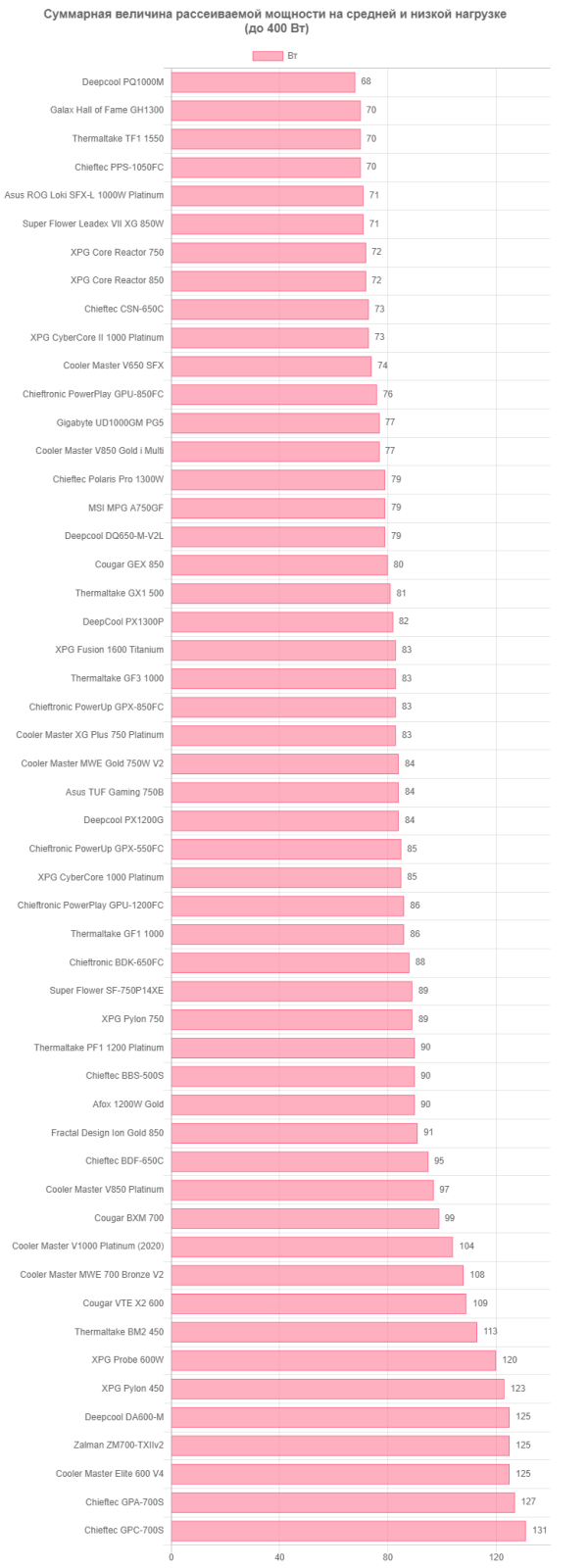
This model has not very impressive efficiency in low-load modes; in the overall rating it is somewhere in the middle, and its capabilities are truly revealed under high load (second place in the rating at a load of 750 W).
| Computer energy consumption per year, kWh | 15 W | 100 W | 200 W | 400 W | 500 W (1 cord) | 500 W (2 cords) | 750 W |
|---|---|---|---|---|---|---|---|
| Cooler Master MWE Bronze 750W V2 | 271 | 1075 | 1979 | 3881 | 4893 | 4872 | 7464 |
| Cougar BXM 700 | 237 | 1035 | 1980 | 3879 | 4883 | 4880 | |
| Cooler Master Elite 600 V4 | 231 | 1032 | 2016 | 4080 | 5195 | ||
| Cougar GEX 850 | 235 | 1003 | 1933 | 3790 | 4739 | 4735 | 7205 |
| Cooler Master V1000 Platinum (2020) | 305 | 1060 | 1975 | 3837 | 4761 | 4739 | 7054 |
| Cooler Master V650 SFX | 200 | 997 | 1924 | 3793 | 4751 | 4743 | |
| Chieftec BDF-650C | 245 | 1042 | 1994 | 3815 | 4991 | 4970 | |
| XPG Core Reactor 750 | 202 | 1001 | 1914 | 3773 | 4746 | 4734 | 7205 |
| Deepcool DQ650-M-V2L | 228 | 997 | 1923 | 3808 | 4765 | ||
| Deepcool DA600-M | 251 | 1049 | 2015 | 4041 | 5133 | ||
| Fractal Design Ion Gold 850 | 262 | 1029 | 1940 | 3830 | 4795 | 4776 | 7273 |
| XPG Pylon 750 | 229 | 1011 | 1942 | 3863 | 4879 | 4877 | 7542 |
| Thermaltake TF1 1550 | 252 | 1008 | 1901 | 3716 | 4643 | 6938 | |
| Chieftronic PowerUp GPX-850FC | 244 | 1015 | 1940 | 3795 | 4725 | 4715 | 7177 |
| Thermaltake GF1 1000 | 265 | 1035 | 1940 | 3780 | 4713 | 4707 | 7139 |
| MSI MPG A750GF | 232 | 1014 | 1936 | 3772 | 4723 | 4713 | 7174 |
| Chieftronic PowerPlay GPU-850FC | 237 | 1015 | 1925 | 3750 | 4678 | 4672 | 7061 |
| Cooler Master MWE Gold 750W V2 | 238 | 1016 | 1936 | 3807 | 4748 | 4744 | 7239 |
| XPG Pylon 450 | 242 | 1038 | 2001 | 4056 | |||
| Chieftronic PowerUp GPX-550FC | 238 | 1011 | 1941 | 3817 | 4793 | ||
| Chieftec BBS-500S | 248 | 1019 | 1947 | 3842 | |||
| Cougar VTE X2 600 | 248 | 1036 | 1997 | 3936 | 4942 | ||
| Thermaltake GX1 500 | 244 | 1000 | 1923 | 3809 | 4797 | ||
| Thermaltake BM2 450 | 238 | 1022 | 1982 | 4011 | |||
| Chieftec PPS-1050FC | 226 | 990 | 1904 | 3759 | 4688 | 4683 | 7078 |
| Super Flower SF-750P14XE | 254 | 1021 | 1954 | 3811 | 4748 | 4765 | 7236 |
| XPG Core Reactor 850 | 217 | 1007 | 1911 | 3758 | 4716 | 4704 | 7122 |
| Asus TUF Gaming 750B | 229 | 997 | 1933 | 3842 | 4824 | 4812 | 7385 |
| Deepcool PQ1000M | 223 | 986 | 1898 | 3750 | 4681 | ||
| Chieftronic BDK-650FC | 242 | 1001 | 1931 | 3864 | 4849 | 4823 | |
| Cooler Master XG Plus 750 Platinum | 252 | 1000 | 1918 | 3824 | 4757 | 4730 | 7105 |
| Chieftec GPC-700S | 268 | 1064 | 2023 | 4060 | 5116 | ||
| Gigabyte UD1000GM PG5 | 228 | 1002 | 1926 | 3779 | 4731 | 4711 | 7153 |
| Zalman ZM700-TXIIv2 | 241 | 1047 | 2022 | 4047 | 5107 | 5081 | |
| Cooler Master V850 Platinum | 287 | 1052 | 1968 | 3806 | 4716 | 4711 | 7083 |
| Thermaltake PF1 1200 Platinum | 244 | 1036 | 1962 | 3811 | 4757 | 4726 | 7159 |
| XPG CyberCore 1000 Platinum | 220 | 1048 | 1941 | 3801 | 4708 | 4702 | 7076 |
| Chieftec CSN-650C | 225 | 986 | 1905 | 3784 | 4761 | ||
| Asus ROG Loki SFX-L 1000W Platinum | 251 | 1003 | 1906 | 3722 | 4719 | ||
| Thermaltake GF3 1000 | 209 | 1025 | 1942 | 3815 | 4772 | 4744 | 7188 |
| Chieftronic PowerPlay GPU-1200FC | 252 | 1033 | 1947 | 3781 | 4695 | 4671 | 7056 |
| Galax Hall of Fame GH1300 | 243 | 1000 | 1911 | 3720 | 4642 | ||
| Deepcool PX1200G | 225 | 1047 | 1964 | 3767 | 4687 | ||
| Powerman PM-300TFX | 237 | 1051 | 2087 | ||||
| Chieftec Polaris Pro 1300W | 247 | 1024 | 1930 | 3751 | 4666 | 4659 | 6991 |
| Chieftec GPA-700S | 249 | 1045 | 2017 | 4066 | 5138 | ||
| XPG Probe 600W | 244 | 1048 | 2010 | 4012 | 5081 | ||
| Afox 1200W Gold | 265 | 1041 | 1961 | 3789 | 4723 | 4712 | 7061 |
| XPG Fusion 1600 Titanium | 254 | 1053 | 1954 | 3727 | 4633 | 7135 | |
| Super Flower Leadex VII XG 850W | 234 | 1003 | 1913 | 3738 | 4662 | ||
| Cooler Master V850 Gold i Multi | 226 | 1004 | 1925 | 3784 | 4704 | ||
| XPG CyberCore II 1000 Platinum | 215 | 1022 | 1913 | 3755 | 4660 | 4656 | 7026 |
| DeepCool PX1300P | 280 | 1032 | 1919 | 3749 | 4643 | 6960 |
In this case, we also provide measurements of traditional efficiency . The results were recorded at a constant load on the +3.3VDC (5 W) and +5VDC (15 W) channels and variable power on the +12VDC channel.
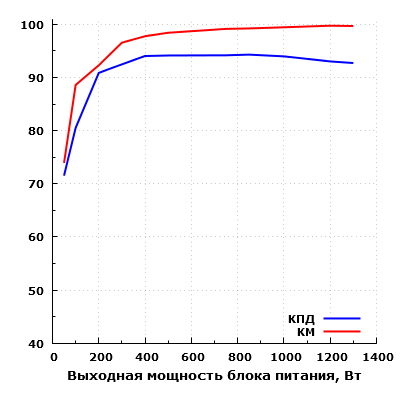
Thus, we measured the parameters of the power supply at 11 points. The maximum efficiency in this case reaches 94.3% with an output power of 850 W. The maximum power dissipation was only 102 W with an output power of 1300 W, which is a very small value for a power supply of this power.
Temperature
All main tests were carried out with a constantly rotating fan. However, we also carried out a separate study of working in hybrid mode. The temperature regime of the capacitors when operating at a power of up to 750 W in standard mode remains at a low level. At maximum power the temperature is quite high, but acceptable.
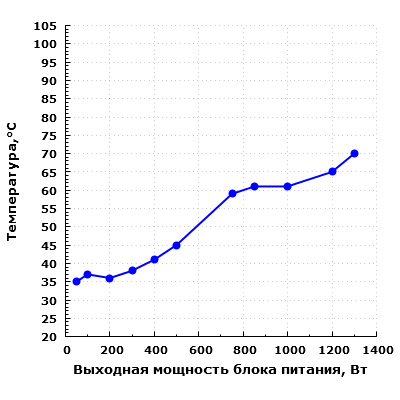
When examining the operation of the power supply in hybrid mode, it was found that the fan turns on both when a certain temperature is reached on the temperature sensor (approximately 65 degrees) and when the output power reaches about 800 watts. The fan turns off only when the temperature at the temperature sensor drops to a certain level (approximately 55 degrees). Consequently, when operating at a power of 800 watts and below, the power supply is capable of operating for a long time with the fan turned off.
No sudden increase in noise level was detected when the fan started.
It should also be noted that when operating with the fan turned off, the temperature of the components inside the power supply is highly dependent on the ambient air temperature, and when set within 40-45 °C, this may lead to the fan turning on earlier.
Acoustic ergonomics
To measure the noise level of power supplies during the preparation of this material, the following methodology was used. The power supply was placed on a flat surface with the fan up, and above it, at a distance of 0.35 meters, the measuring microphone of the Oktava 110A-Eco sound level meter was placed. Noise level measurements were made with this microphone. The power supply was loaded using a special stand with a silent operating mode. The power supply was operated at constant power for 20 minutes, after which the noise level was measured.
The indicated distance to the object under study is the closest to the conditions for placing the system unit with the power supply installed on the table. This power supply noise estimation method provides stringent measurement conditions based on the user's recent location of the noise source. Increasing the distance to the noise source and the presence of additional barriers that have good sound reflecting ability can lead to a decrease in the noise level at the control point, which in turn will improve the overall acoustic ergonomics.
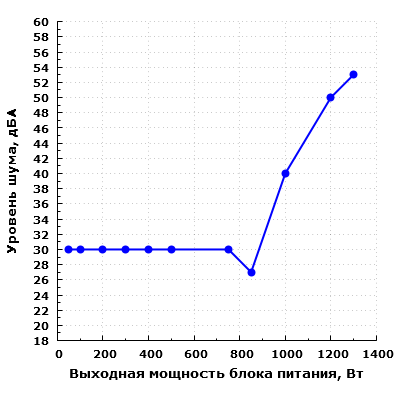
With continuous operation of the fan until a power of about 800 W is reached, the noise level remains constant and low, considered average for a living space during the daytime. However, at 850 W there is a sudden drop in fan speed, making the power supply even quieter (the noise level is reduced to levels typical of residential environments during the daytime). This is likely the result of the convergence of the two cooling modes, as in hybrid mode the fan starts spinning at around 800W.
Further, the fan rotation speed increases sharply, and at a power of 1000 W, the noise level already exceeds 40 dBA, which can be characterized as a high level for residential premises during the daytime.
When operating at a power of 1200 W and above, the noise level becomes very high, suitable not only for residential but also for office premises, exceeding 50 dBA.
Thus, in terms of acoustic comfort, this model provides comfort with an output power of up to 850 W.
We also evaluate the noise level of the power supply's electronic components, as in some cases they can create unwanted sounds. This testing step involves measuring the difference between the noise level in our lab with the power supply turned on and with it turned off. If the difference is less than 5 dBA, then the acoustic characteristics of the power supply remain unchanged. A difference of more than 10 dBA usually indicates the presence of certain defects that can be heard at a distance of less than half a meter. At the measurement stage, the sound level meter microphone is placed at a distance of about 40 mm from the top surface of the power supply, since at longer distances it is difficult to measure noise from electronics.
| Power, W | Noise level from the grille side, dBA | Deviation from background level, dBA |
|---|---|---|
| 50 | 22.7 | 2.7 |
| 100 | 22.7 | 2.7 |
| 200 | 23.0 | 3.0 |
| 300 | 23.3 | 3.3 |
| 400 | 23.4 | 3.4 |
| 500 | 23.4 | 3.4 |
| 750 | 24.0 | 4.0 |
The electronic noise here is minimal; it will be almost impossible to hear it even from a minimum distance, not to mention the assembled system.
Consumer qualities
The DeepCool PX1300P has outstanding consumer performance characteristics, making it an excellent choice for home systems with generic components. The acoustic ergonomics in hybrid mode are impressive, as the fan can remain stationary until a load of 800 W is reached. Even with a constantly rotating fan, the noise level remains low at this power. The power supply also features a high load capacity over the +12VDC channel, high-quality power components, a large number of connectors, and efficient power consumption. Our tests did not reveal any significant flaws.
Among the positive characteristics, it is worth noting the use of Japanese capacitors and a fan with a hydrodynamic bearing. The length of the power supply cables is sufficient for most modern cases, and they are completely removable, which is convenient for installation and maintenance.
Results
The DeepCool PX1300P is an excellent implementation of the «platinum» power supply, corresponding to its price category. The technical and operational characteristics of the power supply are at a high level thanks to the outstanding load capacity of the +12VDC channel, effective energy saving, a high-quality fan with a hydrodynamic bearing and the use of capacitors from Japanese manufacturers. This model promises a long service life, even under high loads and active use. Thanks to the ability to operate for a long time with the fan turned off at a power of up to 800 W, the power supply ensures comfortable and efficient operation.

